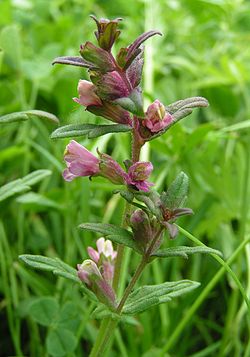| Odontites vernus | |
|---|---|
 | |
| Scientific classification | |
| Kingdom: | Plantae |
| Clade: | Tracheophytes |
| Clade: | Angiosperms |
| Clade: | Eudicots |
| Clade: | Asterids |
| Order: | Lamiales |
| Family: | Orobanchaceae |
| Genus: | Odontites |
| Species: | O. vernus |
| Binomial name | |
| Odontites vernus | |
Odontites vernus, the red bartsia , [1] [2] is a wild flower from the family Orobanchaceae native to Europe and Asia and occurring as an alien in North America. [3] The red bartsia is a common plant in low-fertility soils, where it lives partially as a parasite on the roots of grasses. [4] The red bartsia has pinkish and red flowers from June to September. They prefer dry conditions and full sun light exposure and are pollinated by bees and wasps. [4]
Contents
Over the last 70 years, the red bartsia has disappeared from many woodland locations in the English county of Dorset. [5]
In Manitoba, Canada, the plant known as red bartsia is considered a weed. [6]